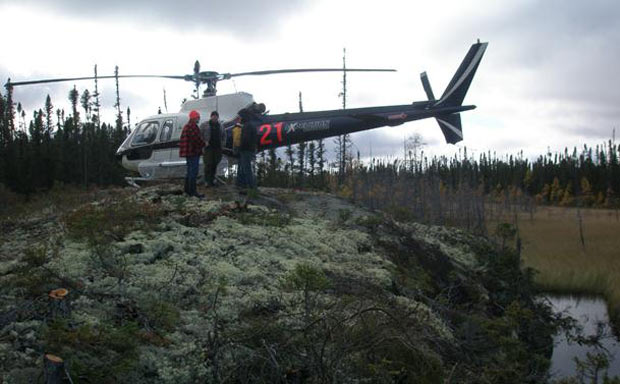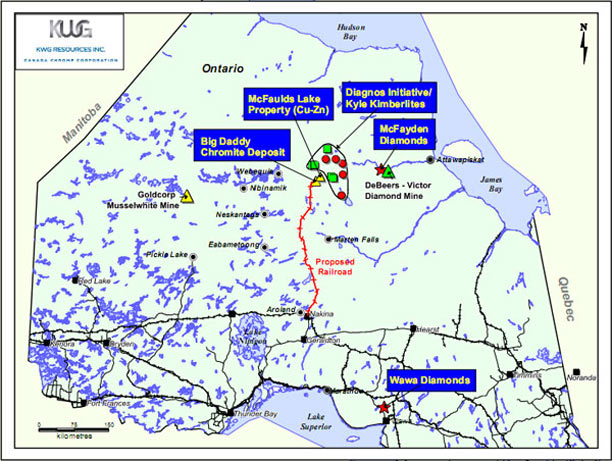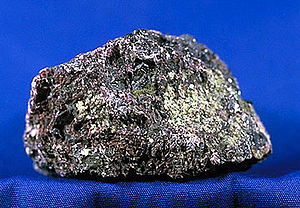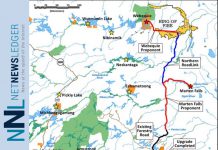

Ring of Fire Chromite Mine Exploration Continues
THUNDER BAY – Bold Ventures Inc. and KWG Resources Inc. (“KWG”) announce jointly the following drilling results from the initial diamond drill program on their Koper Lake Joint Venture in the Ring of Fire (ROF) Northeastern Ontario, which is under option from Fancamp Exploration Ltd. (FNC). In turn KWG has optioned the property from Bold on terms that are described in a Bold press release dated March 4, 2013.
Drilling with three drills commenced early in March 2013. The drilling was briefly halted in early April 2013 pending the issuance of an Exploration Permit by the Ontario Ministry of Northern Development and Mines pursuant to the revised Ontario Mining Act.
In late May while drilling the last two holes of the program a forest fire, in close proximity, threatened the drill camp which housed the project personnel. All personnel were evacuated from the area until the fire was brought under control. As a result, the program budget was exhausted and the last two holes were stopped short of the target depth. Casing for holes FNCB-13-35 and FNCB-13-37 was left in place and capped for access at a later date.
Bold and KWG Working Together
While Bold was the operator of the program, its technical crews were ably assisted with on-site support from KWG’s geologists. First Nations people were employed on site, with Haveman Bros. from Kakabeka Falls near Thunder Bay providing procurement and camp services and Cyr Drilling of Winnipeg, Manitoba and Orbit Garant Drilling of Val-d’Or, Québec providing the contract drills.
During the program a total of ten holes (FNCA-13-29 and 29W1, and FNCB-13-30 to 37) totaling 6040.8 metres were drilled.
Drill Results – Nickel/Copper Massive Sulphide Potential
Hole FNCA-13-29 was collared in the northwest corner of the Fancamp property to provide a platform for down hole geophysical surveying in a northerly oriented ultramafic conduit feeding the northeast–southwest striking Ring of Fire (ROF) ultramafic complex. A similar north-south striking conduit further west hosts the Eagle’s Nest copper-nickel base metal deposit previously discovered by Noront Resources Ltd. in 2007. The hole encountered poor ground conditions and had to be halted before reaching its target depth and was wedged off at 1015 metres. This wedge hole, FNCA-13-29W1, was advanced as far as 1051 metres when the hole was stopped and surveyed with a down-hole electro-magnetic system. Results did not warrant any further drilling from this platform.
Drill Results – Chromite
Holes FNCB-13-30 to 37 were drilled to further explore the Black Horse chromite mineralization previously discovered by FNC (see Fancamp’s press release dated May 24th, 2011) as well as to test for the eastern extension of the Blackbird chromite mineralization located on the adjoining Noront Resources Ltd. claims (see Noront’s press release dated March 20th, 2012). The holes were drilled to test an approximate 800 metre strike length of the Blackbird – Black Horse horizon on the western most claim of the four-claim Koper Lake Property. The program was successful in confirming that chromite mineralization does exist within the Koper Lake property directly to the east of the adjoining Blackbird deposit owned by Noront Resources and also in extending the Black Horse mineralization outwards from previously drilled (2010) holes FN-10-25 and FN-10-26. Further drilling is required in order to understand the spatial relationship of the Blackbird and Black Horse horizons and the continuity and orientation of those mineralized zones.
Highlights
Holes FNCB-13-30, 32 and 33 were drilled to test the down-plunge continuity of chromite mineralization delineated on the adjacent Noront Resources property.
Hole FNCB-13-30 intersected 45.76 metres of chromite mineralization from 655.5 to 701.26 metres consisting of disseminated, heavily disseminated, semi-massive and massive chromite. This intercept contains two intervals dominated by massive chromite: from 664.67 to 677.65 metres (12.98 metres) and from 685.67 to 696.32 metres (10.65 metres). The weighted average percentage of Cr2O3 of these two intervals is 26.44% and 31.89% respectively.
Hole FNCB-13-32 encountered a thin band of massive chromite between 656.13 and 659.0 metres. The intercept assayed 34.48% Cr2O3 over 2.87 metres.
Hole FNCB-13-33 intercepted two intervals dominated by massive chromite, from 695.48 to 721.07 metres (25.59 metres) and from 753.0 to 813.26 metres (60.26 metres). The weighted average percentage of Cr2O3 of these two intervals was 27.98% and 28.31% respectively. These zones were encountered within a broader low-grade horizon of chromite mineralization.
Diamond drill holes FNCB-13-34 and 36 from the same collar location were drilled to test a shallow gravity anomaly which was interpreted to possibly represent the up-dip extension of the Black Horse mineralization.
Hole FNCB-13-34 drilled at -68 degrees encountered disseminated to layered chromite between 127.44 and 144.14. Assay results included 5.66 metres grading 18.51% Cr2O3 (from 137.58 metres to 143.24 metres).
Hole FNCB-13-36 drilled at -45 degrees intersected massive to heavily disseminated chromite between 126.44 and 132.84 metres. Assay results included 4.01 metres grading 18.56% Cr2O3 (from 126.44 metres to 130.45 metres)
Holes FNC-13-35 and 37 were stopped short of target depth. Future plans will include continuing those holes to their completion.
Geophysical Results
The detailed ground magnetometer and gravity surveys have better defined a number of untested targets on the property. The additional geophysical data enhance the possibility of better defining known chromite mineralization as well as testing additional targets.
Future Work
Upon further review and the compilation of relevant data, a follow up program will be developed to further define the chromite horizon as a definable resource as qualified by National Instrument 43-101.
Additional drilling and down hole geophysics is recommended to test the C6 anomaly area for additional Nickel-Copper massive sulphide and chromite deposits.
Additional maps and project details are available on the websites for Bold and KWG at www.boldventuresinc.com and www.kwgresources.com respectively.
Bruce Mackie P. Geo., a Qualified Person (QP) under National Instrument 43-101, is the QP with respect to the nickel-copper massive sulphide and geophysical exploration component of this project and has reviewed and approved the related information within this press release. M.J.(Moe) Lavigne, P.Geo, is the QP with respect to the chromite exploration component of this project and has reviewed and approved the related information within this press release.
Sample Preparation, Analyses and Security

The assay and sample information as well as geological descriptions are taken from drill logs as prepared by the project geologists for the drill program. All drill core was NQ in size and assays are completed on split or sawed half-cores, with the second half of the core kept for future reference. The samples are put into rice bags which are sealed with security locks for shipping directly to Activation Labs (“Actlabs”), an accredited assay laboratory, in Thunder Bay, Ontario.
Stringent QAQC procedures are followed. Samples are shipped to the laboratory in batches of 35 samples. Each sample batch includes 2 standards, 1 blank, and 1 duplicate that are inserted on site, plus a duplicate coarse reject and 1 duplicate pulp that are prepared at the laboratory and inserted. In addition, Actlabs also employs a rigorous in-house QAQC regime which includes standards, blanks and duplicates.
Once the final assays are received from Actlabs and prior to any data being released to the public, a review of all QAQC data is conducted by an independent qualified person to ensure that the data released are within predetermined norms.
All samples are analysed by Actlabs at either their main laboratory in Ancaster, Ontario or at their Thunder Bay, Ontario facility. Both laboratories are ISO accredited. All samples are:
- Assayed for Au, Pd & Pt by fire assay with an ICP/OES finish (Actlabs code 1C-OES).
- Assayed for 13 major element oxides, including Cr2O3 by fusion-XRF (Actlabs code 4C).
For additional information on assay methodology visit the Actlabs website at www.actlabsint.com.
For more information, please visit www.boldventuresinc.com or contact Bold Ventures Inc. at 416-864-1456.











